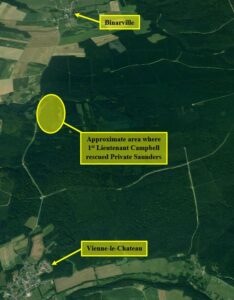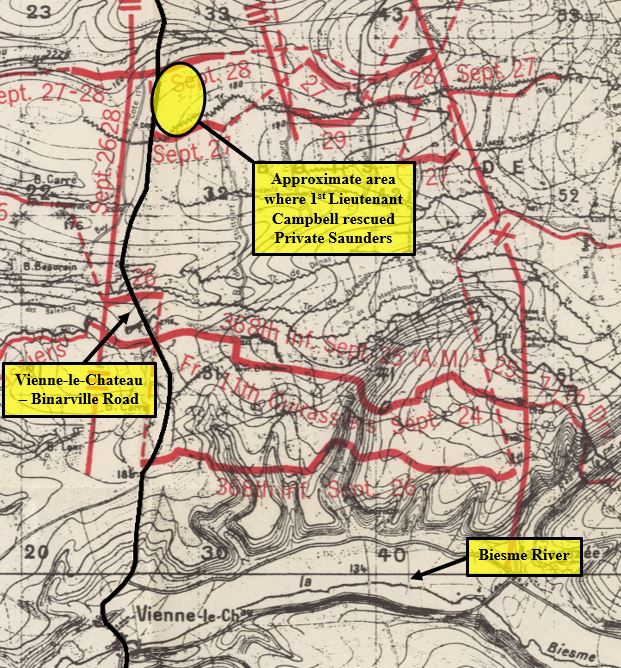Robert Lee Campbell
Robert Lee Campbell’s Personal Narrative was derived from information found in public records, military personnel files, and local/state historical association materials. Please note that the Robb Centre never fully closes the book on our servicemembers; as new information becomes available, narratives will be updated to appropriately represent the life story of each veteran.
Please contact the Robb Centre for further clarification or questions regarding content or materials.
Military Honor(s):
Distinguished Service Cross
Citation: The President of the United States of America, authorized by Act of Congress, July 9, 1918, takes pleasure in presenting the Distinguished Service Cross to First Lieutenant (Infantry) Robert L. Campbell, United States Army, for extraordinary heroism in action while serving with 368th Infantry Regiment, 92d Division, A.E.F., near Binarville, France, 27 September 1918. In the afternoon of September 27 Lieutenant Campbell saw a runner fall wounded in the middle of a field swept by heavy machine-gun fire. At imminent peril to his own life, and in full view of the enemy, he crossed the field and carried the wounded soldier to shelter.
Croix de Guerre with Silver Gilt Star
Citation: Order No. 17.470 "D". "With approbation of the commander in chief of the American expeditionary forces in France, the marshal of France, commander in chief of the French armies of the east cities in the order of the army corps: Lieut. Robert L. Campbell, 368th American Infantry Regiment. Officer of admirable courage. Seeing a wounded liaison agent fall in the middle of a field swept by violent fire, he went to his assistance in plain view of the enemy and brought him to shelter".
Life & Service
- Birth: 28 March 1875, Athens, GA, United States
- Place of Residence:
- Race/Ethnicity: African American
- Death: 2 January 1972 Los Angeles, CA, United States
- Branch: Army
- Military Rank: First Lieutenant
- Company: [I]
- Infantry Regiment: 368th
- Division: 92nd
Robert Lee Campbell was born on 28 March 1875 in Athens, Clarke County, Georgia to James Wilkins (?-?) and Ann Harding (?-?). Details related to Ann Harding Wilkins Campbell are sparse- the only record stating parentage is Campbell’s Social Security Application. Little is known of his early life, only that he attended school at the Tuskegee Institute in Tuskegee, Alabama, at one point, taking a leave of absence to serve in the United States Army.
“Lt. Robert L. Campbell, a graduate and former instructor at Tuskegee Institute, was one of fourteen United States soldiers in France recently decorated with the distinguished service cross by General Pershing. Lt. Campbell was born at Athens, Ga. He entered the Training Camp for Officers at Camp Des Moines, Iowa, June 17th of last year and was later commissioned a first lieutenant.”
Campbell married Alyce/Alice Mulligan (1886-1955) sometime before 1907, they had one daughter, Anna (1907-1986).
By 1900, Campbell was a Corporal stationed in Las Pinas, Philippine Islands during the Philippine Insurrection; he had previously served in Mexican Border War in 1899. Campbell returned to teach in Meridianville, Alabama. Campbell was discharged in 1911, but soon reenlisted 15 June 1917 to attend Officer’s Training School at Fort Des Moines, Iowa. Newly commissioned 1st Lieutenant Campbell left Hoboken, New Jersey on 15 June 1918 with Co. I, 368th Infantry Regiment aboard U.S. Army Transport Ship George Washington, arriving in Brest, France on 21 June. 1st Lieutenant Campbell received the Distinguished Service Cross and French Croix de Guerre with Silver Gilt Star for his actions on 27 September 1918 near Binarville, France;
“The President of the United States of America, authorized by Act of Congress, July 9, 1918, takes pleasure in presenting the Distinguished Service Cross to First Lieutenant (Infantry) Robert L. Campbell, United States Army, for extraordinary heroism in action while serving with 368th Infantry Regiment, 92d Division, A.E.F., near Binarville, France, 27 September 1918. In the afternoon of September 27 Lieutenant Campbell saw a runner fall wounded in the middle of a field swept by heavy machine-gun fire. At imminent peril to his own life, and in full view of the enemy, he crossed the field and carried the wounded soldier to shelter”. War Department, G.O. No. 17, 1919.
“General Headquarters of the French Armies of the East, Staff, Personnel Bureau, Order No. 17.470 “D”. With the approbation of the commander in chief of the American Expeditionary Forces in France, the marshal of French, commander in chief of the French Armies of the east cities in the order of the army corps: Lieut. Robert L. Campbell, 368th American Infantry Regiment. Officer of admirable courage. Seeing a wounded liaison agent fall in the middle of a field swept by violent fire, he went to his assistance in plain view of the enemy and brought him to shelter. At General Headquarters, May 17, 1919. The Marshal of France, Commander of the French Armies of the East. Petain, For original extract; the lieutenant colonel, chief of personnel bureau”.
1st Lieutenant Campbell and his company left Brest, France on 3 March 1919 aboard the U.S. Army Transport Ship Agamemnon, arriving in Hoboken, New Jersey on 11 March. 1st Lieutenant Campbell was Honorably Discharged on 24 October, but reenlisted soon after, date unknown. Campbell received the Croix de Guerre in October of 1919;
“It was very flattering that this decoration should have taken place on the A. and T. college campus for several reasons. First, because it is Lt. Campbell’s home, where he has worked for a number of years as an instructor in this institution. Second because of the presence of a large body of negro youth, most of whom were members of the reserve officers training corps of the A. and T. college. Third, because it brings to this institution a peculiar distinction which it richly deserves for the part it played in the great world war, for from it went five teachers to the training camp at Des Moines, Ia…First Lieutenant Campbell was formerly in charge of the R.O.T.C. at this institution and we regret very much indeed that he has received orders from the War Department transferring him to the A. and M. college at Normal, Ala.”
1st Lieutenant Robert Lee Campbell served in Company [I], 368th Infantry Regiment, 184th Infantry Brigade, 92nd Division. At the time of his citation for the Distinguished Service Cross, this unit was operating as a provisional brigade named Groupement Durand, which served as a liaison between the French XXXVIII Army Corps and the American 77th Division, I Corps. The following his story:
Near Binarville, France – 27 September 1918
25 September 1918:
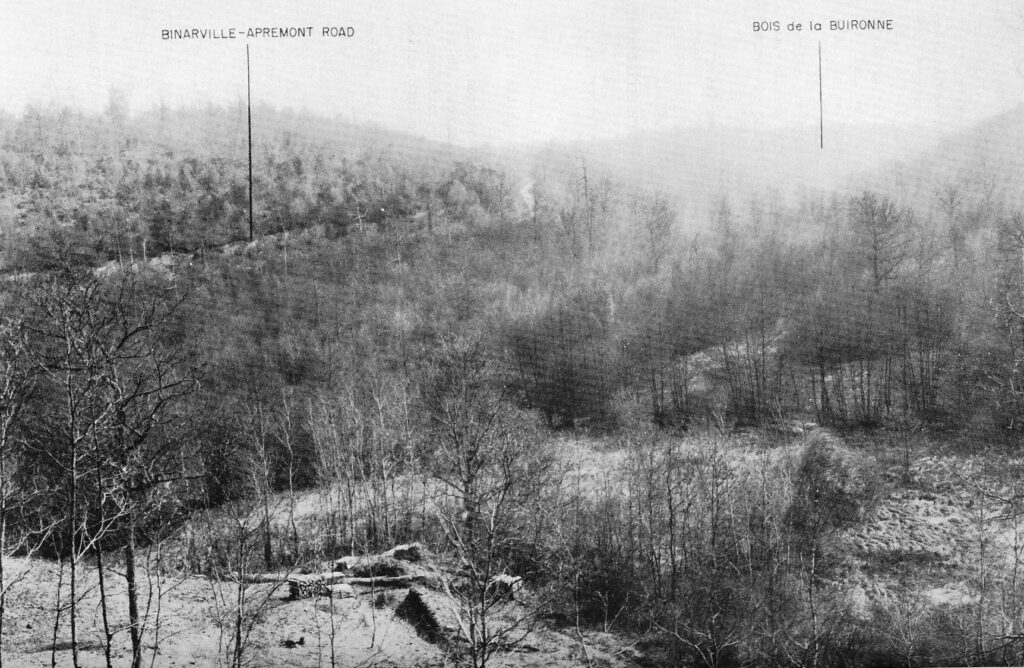
This picture, taken just north of Groupement Durand’s area of operations, gives an idea of the difficulties that the 368th faced advancing through the Argonne.
After receiving orders to advance north from the River Biesme, the 368th Infantry Regiment and the French 11th Cuirassiers, which together made-up Groupement Durand, began its movement during the night of 25 September and the early morning of 26 September 1918. The Franco-American unit advanced to staging areas just north of the river in preparation for maneuvers for the following day. Groupement Durand’s main objective was to maintain liaison between the French Fourth Army, located to the west, and the American First Army to its east.
Facing the 368th Infantry were rows of heavy German barbed-wire, concealed machine-gun nests, trenches, and the blown-out remains of the Argonne Forest. The rough terrain created, and German defenses marked the area as one of the best-fortified regions of the German Army’s western front. Although a French artillery attack had been scheduled to commence at 2330 hours (11:30 P.M.) on the night of the 25th to soften the German defenses, the artillery was ineffective and left the German defenses virtually untouched.
26 September 1918:
At 0530 hours (5:30 A.M.), the 2nd Battalion of the 368th Infantry Regiment began their advance and almost immediately encountered heavy German resistance. To complicate matters, the men of the 368th Infantry Regiment faced critical supply shortages, most notably water reserves and heavy wire-cutters, whereby absence of the latter made forward movement through the German defenses virtually impossible. Regardless, some elements of 2nd Battalion fought their way to the rear of the German frontline. However, the terrain, dense fog, and relentless machine-gun fire had forced these advanced elements to break into small parties that would advance or withdrawal at their discretion.
Meanwhile, 1st Lieutenant Robert Campbell and the men of 3rd Battalion, 368th Infantry Regiment, had received orders to rapidly advance, however, maintaining liaison with the French and Americans on either flank during such an advance became impossible. Communications between Groupement Durand, the French, and the Americans would become inconsistent throughout the day. By 2359 hours (11:59 PM) liaison had been completely lost between the 368th Infantry Regiment and both flanks. Further, contact with several platoons of 2nd Battalion could not be made, as they had remained deep within German territory.
27 September 1918:
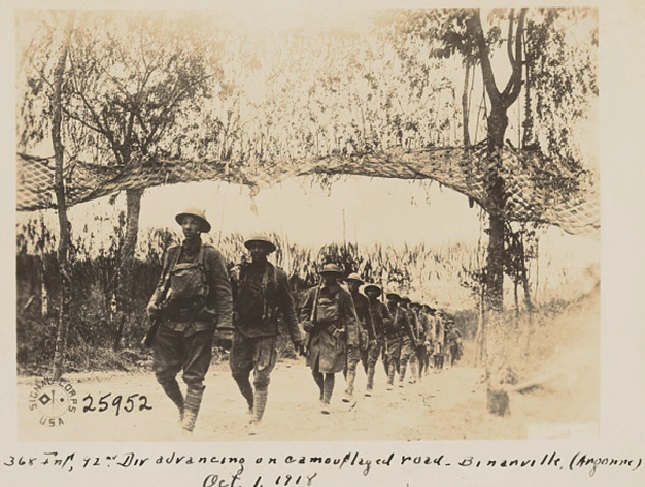
368 Inf, 92nd Div. advancing on camouflaged road – Binarville (Argonne) Oct 1, 1918
The 368th Infantry Regiment spent the early hours of 27 September following the same path made the previous day. By morning, the 2nd and 3rd Battalions of the 368th Infantry had reclaimed much of what they’d failed to hold the day before. Both battalions began occupying the better part of the German frontline.
In the afternoon, as the 3rd Battalion, 368th Infantry Regiment made further preparations to advance north along the Vienne-le-Chateau – Binarville road, a call was put out for a runner to deliver a message from Company [I] to Company [M]. Private Edward Saunders answered this call, however, within moments of going over the top he was wounded. As he laid wounded and bleeding in the cold, wet mud, he desperately called out for help to aid him to deliver his message and care to his wounds.
Hearing the boy’s cries for help, 1st Lieutenant Robert Campbell burst from his line into the open field, despite the German machine-gun bullets whizzing past and the high-explosive artillery raining down around him. 1st Lieutenant Campbell had no intention of picking up his subordinate’s mission where it had been cut short – the message could wait; Saunders could not. Campbell ran to Private Saunders, clutched him tightly and carried him back to the safety of their trench, all the while the machine-gun bullets screamed closer to the pair while the German artillery shook and tore the ground around them.
In recognition of this heroic act, Campbell was awarded the Distinguished Service Cross and the Croix de Guerre with Bronze Palm.
Campbell, in between his terms of service, was a professor briefly at Alabama A&M University (later sent back to establish the campus’ ROTC program), but settled in Greensboro, North Carolina as North Carolina A&T University’s first military science professor. The Campbells lived at 913 Lindsey Street, Greensboro, North Carolina. Campbell also established NC A&T’s Reserve Officer Training Corps program, in 1955 having the honor of becoming the namesake of the campus’ ROTC building.
After Alyce Mulligan Campbell’s death in 1955, Campbell moved to Los Angeles, California, living with his daughter, son-in-law, and grandchildren at 1131 Adeline St. There, he met Odessa Sapp (1912-1992), marrying her in the late 1960s, but divorcing not long afterwards.
Campbell died on 2 January 1972 in Los Angeles, and is buried at Los Angeles National Cemetery.
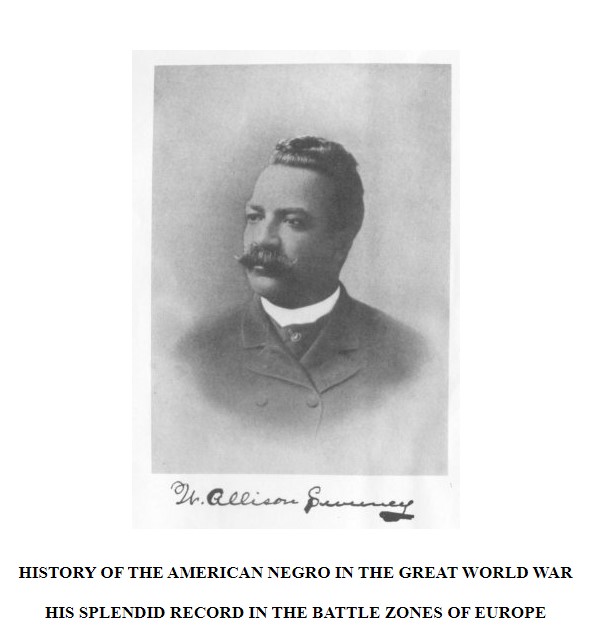
Excerpt from W. Allison Sweeney's History of the American Negro in the Great World War
“Individual exploits were quite numerous and were valiant in the extreme. Here is an instance:
It became necessary to send a runner with a message to the left flank of the American firing line. The way was across an open field offering no covering or protection of any kind, and swept by heavy enemy machine gun fire.
Volunteers were called for. A volunteer under such circumstances must be absolutely fearless. The slightest streak of timidity or cowardice would keep a man from offering his services. Private Edward Saunders of Company I, responded for the duty. Before he had gone far a shell cut him down. As he fell he cried to his comrades:
Someone come and get this message. I am wounded.
Lieutenant Robert L. Campbell, a Negro officer of the same company sprang to the rescue. He dashed across the shell-swept space, picked up the wounded private, and, with the Germans fairly hailing bullets around him, carried his man back to the lines. There was the case of an officer who considered it more important to save the life of a heroic, valuable soldier than to speed a message. Besides the wounded man could proceed no farther and there were other ways of getting the message through and it was sent.
For the valor shown both were cited for the Distinguished Service Cross. Lieutenant Campbell’s superiors also took the view that in that particular instance the life of a brave soldier was of more importance than the dispatch of a message, for as a result, he was recommended for a captaincy…
…Under the same Lieut. Robert Campbell, a few colored soldiers armed only with their rifles, trench knives, and hand grenades, picked up from shell holes along the way, were moving over a road in the Chateau Thierry sector. Suddenly their course was crossed by the firing of a German machine gun. They tried to locate it by the sound and direction of the bullets, but could not. To their right a little ahead, lay a space covered with thick underbrush; just back of it was an open field. Lieutenant Campbell who knew by the direction of the bullets that his party had not been seen by the Germans, ordered one of his men with a rope which they happened to have, to crawl to the thick underbrush and tie the rope to several stems of the brush; then to withdraw as fast as possible and pull the rope making the brush shake as though men were crawling through it. The purpose was to draw direct fire from the machine gun, and by watching, locate its position.
The ruse worked. Lieutenant Campbell then ordered three of his men to steal out and flank the machine gun on one side, while he and two others moved up and flanked it on the other side.
The brush was shaken more violently by the concealed rope. The Germans, their eyes focused on the brush, poured a hail of bullets into it. Lieutenant Campbell gave the signal and the flanking party dashed up; with their hand grenades they killed four of the Boches and captured the remaining three—also the machine gun. There was an officer who could think and plan in an emergency, and evolve strategy like a Napoleon.”
